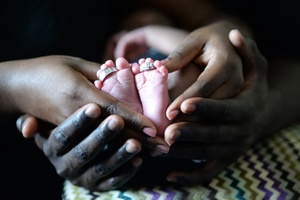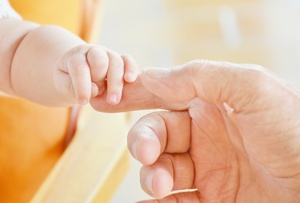In general, there is more risk to the newborn when the cesarean section is scheduled, since it is not the "random" date of a natural birth.
What are they?
During a vaginal delivery, the baby's lungs are compressed through the mother's pelvis and vagina. This facilitates the expulsion of the liquid they contain. This step is not performed during a cesarean section, which increases the risk of possible respiratory distress. Airway suctioning will therefore be performed more frequently during a cesarean section. However, you can wait a few moments to see if the baby is breathing well and then refrain from doing so.
- If the fluid is stained by meconium because of possible fetal distress, there is a risk that the baby will breathe in the meconium. In some cases, this may justify a stay in a neonatal unit.
- If the cesarean section is scheduled, premature and performed outside of labor, the baby does not benefit from the action of the hormones secreted and useful for lung maturation.
Respiratory distress occurs in 35.5 of every 1000 deliveries of non-labor cesarean sections. Only 12.2 per thousand caesarean sections occur in labor and only 5.3 per thousand in vaginal births. The earlier the cesarean section is performed, the higher the risk.
Recent cesarean section techniques in which the uterus is precisely incised limit the risks of damage and injury to the baby. Only in about 1% of cases are there slight superficial cuts on the baby's body.

During a cesarean section, presenting the baby to the conscious mother immediately after delivery is not yet a common practice, so the baby's first contact with his mother is often more difficult. The baby can be placed in an incubator or under lamps to be warmed. The medical team sometimes performs a battery of treatments before placing the baby on his mother's skin or in the father's arms. Yet much of this care could wait. A cold operating room and hospital protocols are obviously not the ideal meeting place. However, there are maternity wards in which the father is allowed to attend the delivery by caesarean section and in which he is allowed to cut the umbilical cord himself. The baby is removed with the placenta, but this is not a common practice. There are almost no studies on the consequences of a cesarean birth, on the behavior or on the impact on the personality or on the development of children born under such conditions.
Long-term risks?
Long-term risks have also been highlighted: risks of asthma mainly if the cesarean section is associated with respiratory distress. The risks of allergy are also increased because of the absence of contact of the baby with the bacteria of the vaginal flora, in particular the lactobacilli. This is finally starting to be recognized by birthing services and by gynecologists and pediatricians. The baby's mouth in contact with the vaginal mucus absorbs the germs that will colonize the intestines. This will quickly provide better protection due to a more effective immune system. It has been clearly demonstrated that the intestinal flora of children born by cesarean section is different from that of children born by vaginal delivery. This could explain the more favorable terrain for food and respiratory allergies in babies born by cesarean section.
Remember that breastfeeding provides a protective effect from an immune point of view. This can certainly reduce the risk of developing allergies in children.
It is no secret that during a C-section, the child does not take the classical route to life. Energetically, this can also be a problem, as the "normal" physiological exit during childbirth ends and passes through the mother's root chakra. It is an essential passage both from an energetic and symbolic point of view. It is at this moment that the child "takes root", that it is incarnated. It finds its own roots, but it also passes through the ways that rooted all its forefathers and the whole human species. Children born by caesarean section should all be able to benefit from energy anchoring and symbolic work in order to reconnect to their ancestral and family roots, but also to the roots of all humanity.

Consequences of using anesthetic products.
During the anesthesia (total or epidural) that accompanies the cesarean section, the baby inevitably receives a small portion of the anesthetic products. This can affect her tone and sucking ability immediately after birth, especially when the epidural labor is long, which allows time for the anesthetics to diffuse through the bloodstream. This phenomenon is less marked in the case of a cesarean section without a prior epidural. In this case, the baby is taken out of the womb very quickly after the anesthesia is started, so it receives only a minimal dose of the product. Although there are ways to clean up these chemical traces for both the baby and the mother, it is best to avoid them.
Date of accouchement imposed.
The opinions are increasingly leaning towards the fact that it would be the baby who, when ready, would trigger the delivery. In a scheduled delivery or cesarean section, the baby will not have chosen its time. We can therefore assume that if he did not manifest himself, it is because he was not quite ready to be born. For example, it could be 300-800 grams short of its actual birth weight. This may be marked by physical weakness or a lack of energy for sucking. He may not latch on often enough. If this is the case, it is up to the mother to observe and offer the breast as often as possible.
Of course, nothing proves all that, since we don't know what would have happened if baby had stayed longer in his mother's belly...



